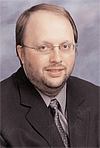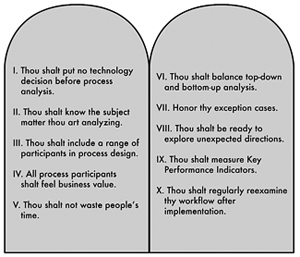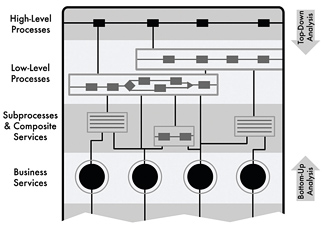Following the 10 IT Commandments

"Art is born of the observation and investigation of nature" said Roman philosopher Cicero. Oftentimes the work of someone looking at a facility can be as much an art as it is a science.
That being said, there are some good guidelines that can be followed when working out the best way for your facility to operate. What follows are the ten basic commandments for analysts (See figure 1).
I. Thou shalt put no technology decision before process analysis.
The business comes first. Making technology decisions based on features, prices, or vendor relationships is a sure-fire way to end up mired in a workflow spider web. Business goals (what an enterprise wants to do) drive business processes (how the enterprise wants to do it), which drives technology decisions (what works in the way the enterprise wants to work). Having technology decisions drive business processes puts an enterprise in danger of also having the technology drive business goals.
II. Thou shalt know the subject matter thou art analyzing.
This advice is to media enterprises that hire business analysts or contract with general consulting companies to provide analysis for them. It is an unfortunate trend in the IT industry that Business Process Analysis (BPA) is a skill set in itself. This is a dangerous concept, because BPA should be driven by those that drive the business itself. Horror stories of generic analysts coming in to a media enterprise and getting the business process wrong are far too common.

The Ten IT CommandmentsIII. Thou shalt include a range of participants in process design.
Analysis is best when it is cross-departmental and covers many areas of concern. It should represent the holistic view of the enterprise, unhindered by any particular technology, silo, or perspective. This is why it is so important to include every type of process participant when eliciting and analyzing workflow.
This is not to say that every last participant needs to be interrogated, but that a thorough process analysis cover all bases. There may be organically developed, undocumented workarounds at the lowest levels of a process that are the key to process efficiency at the highest levels. If a business analyst only talks to the managers of a given department or organization, these crucial details are easily missed.
IV. All process participants shalt feel business value.
This commandment is arguably the most difficult of all of the best practices. It is clear that the types of business processes most likely to succeed when implemented in a given facility are those that help everyone.
The number one reason that formalized processes fail in an enterprise is simple: people just don't follow them. This is often because the individual contributors to a process aren't given enough impetus to contribute.
V. Thou shalt not waste people's time.
Don't drag out this process! Analysis is implemented to address a long-term strategic goal of increasing workflow efficiency. This means that all of those process participants who must be included in process design have daily workloads to get to.
Regardless of the current state of the business processes in an enterprise, the people most crucial to changing that state are the ones knee-deep in the processes every day, and that fact should be respected by analysts who hope to elicit useful information out of process participants.
VI. Thou shalt balance top-down and bottom-up analysis.
Top-down analysis is starting with the high-level business goals and, from there, deriving lower-level processes. Bottom-up analysis is starting with the desk procedures that are carried out by individual process participants and, from there, deriving higher-level processes. (See Fig, 2)
A good workflow analysis process is more "outside-in." It starts by examining the high-level business goals of the workflow and thereby identifying the highest-level processes. But, before getting mired in the middle processes that may or may not be the right way to achieve those high-level goals, a business analyst should also examine the best and most efficient way that individual contributors do their work.
VII. Honor thy exception cases.
No process, no matter how well thought out, is perfect. There will always be some unknown that must get worked into the design, or some unforeseen circumstance that causes participants to develop a workaround. Exception cases are unavoidable. While it is not possible to capture every single exception case in a process model, it is possible to capture the bulk of them. A good analyst will do just that: providing decision points and additional task details to inform exception handling.
VIII. Thou shalt be ready to explore unexpected directions.
The lesson of this commandment is that an enterprise should not take anything for granted when considering new business processes. If a facility has worked one way for 20 years and is looking for ways to increase efficiency, the stakeholders in that process should be willing to sacrifice the way it's always been done in order to facilitate the necessary changes. By setting arbitrary rules and conditions, an enterprise is not being open-minded to change and therefore will not be prepared for necessary change.

The Top-Down versus Bottom-Up AnalysisIX. Thou shalt measure Key Performance Indicators.
Good visibility into a facility's inner workings is important, and one of the main ways in which that visibility is achieved is through the use of Key Performance Indicators, or KPIs. Without KPIs, no one is able to tell whether an improvement initiative is a success or a failure, and so no one will know whether it was money wasted or a process to be repeated. Good KPIs provide irrefutable facts about the quality of a business process, and so should be a part of every analysis.
X. Thou shalt regularly reexamine thy workflow after implementation.
This final commandment is, to a certain extent, the most important of all. Enter-prises change and evolve as business goals and external influences change. Using a formalized, but outdated business process to accomplish the work of a facility is worse than using an informal process, because it forces users to work against the goals of an enterprise instead of, at the very least, organically responding to them.
Sir Winston Churchill, British prime minister, said, "We shape our buildings; thereafter they shape us." Don't let the way things are in your facility now drive the future. If you remain focused on these "commandments" when analyzing what is going on in your facility, you will almost certainly succeed in making positive changes. You can Count on IT!
John Footen is a vice president at National TeleConsultants and the head of its Software Solutions Group. He is also co-author of the book "Service-Oriented Media Enterprise." He can be reached atjfooten@ntc.com.
Get the TV Tech Newsletter
The professional video industry's #1 source for news, trends and product and tech information. Sign up below.
With more than three decades of M&E experience under his belt, John Footen is a managing director who leads Deloitte Consulting LLP’s media technology and operations practice. He has been a chairperson for various industry technology committees. He earned the SMPTE Medal for Workflow Systems and became a Fellow of SMPTE. He also co-authored a book, called “The Service-Oriented Media Enterprise: SOA, BPM, and Web Services in Professional Media Systems,” and has published many articles in industry publications.

